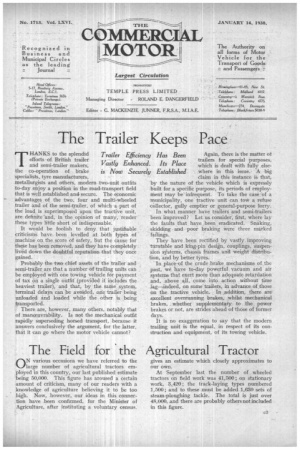The Trailer Keeps Pace
Page 1

If you've noticed an error in this article please click here to report it so we can fix it.
THANKS to the splendid . efforts • of British trailer and semi-trailer makers, the co-operation of bra.ke is Now Sean specialists, tyre manufacturers, metallurgists and others, modern two-unit outfits to-day enjoy a position in the road-transport field that is well established and secure. The economic advantages of the two, four and multi-wheeled ., trailer and of the semi-trailer, of which a part of the load is superimposed upon the tractive unit, are definite 'and, in the opinion of many, -render these types little short of indispensable.
It would be foolish to deny that justifiable criticisms have been levelled at both types of machine on the score of safety, but the cause for these has been rernoved, and they have completely lived down the doubtful reputation that they once gained.
Probably the two chief assets of the trailer and semi trailer are that a number of trailing units can be employed with one towing vehicle for. payment of tax On a single outfit (provided it includes the heaviest trailer), and that, by the same system, terminal delays can be avoided, one trailer being unloaded and loaded while the other is being transported.
There are, however, many others, notably that of rnanceuvrability. Is not the mechanical outfit rapidly superseding horsed transport, because it answers conclusively the argument, for the latter, that it can go where the motor vehicle cannot? Again, there is the matter ot trailers for special purposes, which is dealt with fully elseeiy Established *here in this issue. A big claim in this instance is that, by the nature of the vehicle which is expressly bitilt for a specific purpose, its periods of employment may be-infrequent. To take the case of a municipality, one tractive unit can tow a refuse • -collector, gully emptier or general-purpose lorry. In what manner have trailers and semi-trailers • been improved? Let us consider, first, where lay the faults that have been eradicated. Snaking, skidding and poor braking were three marked failings.
Trailer Efficiency Has Been Vastly Enhanced. Its Place
failings.
They have been rectified by vastly improving turntable and lcing-pin design, Couplings, suspension sYsterns, chassis frames and weight distribu tion, and by better tyres. • In place of the crude brake mechanisms of the past, we have to-day powerful vacuum and air • systems that exert more than adequate retardation and, above all, come into action without time lag—indeed, on some trailers, in advance of those -on the tractive vehicle. In addition, there are .excellent overrunning brakes, whilst mechanical brakes, whether supplementary to the power brakes or not, are strides ahead of those of former days.
It is no exaggeration to say that the modern • trailing unit is the equal, in respect of its construction and equipment, of its towing vehicle.


































